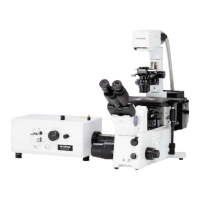APPLIED OPERATIONS/Changing the Image Display Method
IV.
OPERATION INSTRUCTIONS
IV .
2-213
Page
Click and hold the <Display> button for successive display. To stop it, click
the <Display> button again.
Simply clock the <Display> button for frame-by-frame display.
2-5-7 Displaying Multiple Image Slices Together
With images composed of multiple slices, such as time-lapse images or images
acquired by changing the cross-sections, the image slices can be displayed together for
simultaneous viewing. However, note that the size per image reduces when the number
of displayed image slices increases.
Use the [Tile] panel for displaying images together.
Display the [Tile] panel.
Fig. 2-74 [Tile] panel
[Tiling] group box
Shows how the images are displayed in
the
Dis
la
anel.
[Columns] text box
Sets the number of columns, or the
number of image slices displayed in a
horizontal row.
[Rows] text box
Sets the number of rows, or the number o
image slices displayed per vertical
column.
[Experiment]
Shows the acquisition parameters used in
acquisition of the displayed images.
Icon of the displayed images (image
slices shown together).
[Tile Over] drop-down list
Select the acquisition parameter to be
based on when arranging the images.
[Self], [Z] or [T] can be selected.
[Display Type] drop-down list
Select the display method.
[Single View], [Side by Side Views] or
[Over and Under Views] can be
selected.
<Retile> button
Displays the images by arranging them in
the currently displayed [Display] panel.
[New Page] button
Displays images by arranging them in
a new [Display] panel.
[Delete Page] button
Deletes the [Display] panel being
displayed.
TIP

